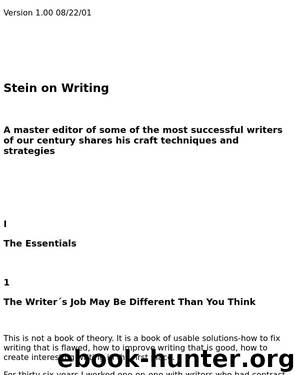Stein on Writing by Sol Stein

Author:Sol Stein
Language: eng
Format: epub
Mingled in Shirley's thoughts are the following flashback thoughts:
1. What she thought about the moon when she was a child.
2. The unwashed dish with the remains of her dinner.
3. The diary she should have burned.
4. Al, who loved her.
5. Her father.
6. A traffic accident with a badly injured woman.
7. Al's comments about how she looked naked.
Why the flashback thoughts? If in the first chapter the reader saw an unknown woman trying to commit suicide, the reader's emotions would not be engaged in any important way. You have to know the people in the car before you see the car crash. Shirley's flashback thoughts, added to her thoughts in the present, are how the reader gets to know Shirley and begins to want her not to jump.
Note that the flashback thoughts are part of a visual scene in the present, a young woman up on a parapet, ready to jump. If the flashback element is to consist of more than quick thoughts in an ongoing scene, the writer must be certain to create a flashback scene that stands on its own to avoid the flashback becoming a narrative of something that happened elsewhere. To move from what is happening in the present to a scene from the past without breaking the reader's experience requires segueing to a scene in the past as inconspicuously as possible.
The term segue is derived from music. It means to glide unobtrusively into something new. I prefer the segue into a flashback to the more direct method, moving from the present scene to a scene in the past inconspicuously.
Flashbacks normally decrease suspense, but they can be fashioned to increase suspense. For instance, in The Best Revenge there is a single scene that runs for three chapters. It is the fierce facing-off of the protagonist, Ben Riller, and the antagonist, Nick Manucci. To heighten the suspense of that confrontation, I inserted three flashbacks into the scene, remembered by Nick, designed to increase the suspense by postponing the outcome of the confrontation. Each of the flashbacks illuminates the long scene and adds to its meaning. And each is segued into and out of as surreptitiously as possible.
In the course of the same novel one learns a great deal more about the antagonist in flashbacks from his wife's point of view. We find out what kind of lover Nick is, why she married him, and what happened to that marriage. An antagonist, characterized in depth, has come to life ´s a credible human being, a person who holds the reader's interest, however inhumane his methods. Saul Bellow said that Nick Manucci, the villain, was the best character in the book. I believe Nick's flashbacks and those of his wife contributed to that view.
If the ghost of Sinclair Lewis is within earshot, I say flashbacks done correctly can provide richness and depth to a novel as long as they don't read like flashbacks, if they are active scenes slipped into and out of simply and quickly.
If you have a flashback in
Download
This site does not store any files on its server. We only index and link to content provided by other sites. Please contact the content providers to delete copyright contents if any and email us, we'll remove relevant links or contents immediately.
Asking the Right Questions: A Guide to Critical Thinking by M. Neil Browne & Stuart M. Keeley(5357)
Autoboyography by Christina Lauren(5086)
Dialogue by Robert McKee(4160)
Eat That Frog! by Brian Tracy(4149)
Sticky Fingers by Joe Hagan(3912)
Journeys Out of the Body by Robert Monroe(3460)
Annapurna by Maurice Herzog(3298)
Full Circle by Michael Palin(3268)
Elements of Style 2017 by Richard De A'Morelli(3237)
Schaum's Quick Guide to Writing Great Short Stories by Margaret Lucke(3187)
The Art of Dramatic Writing: Its Basis in the Creative Interpretation of Human Motives by Egri Lajos(2857)
The Diviners by Libba Bray(2800)
Why I Write by George Orwell(2775)
The Mental Game of Writing: How to Overcome Obstacles, Stay Creative and Productive, and Free Your Mind for Success by James Scott Bell(2766)
In Patagonia by Bruce Chatwin(2755)
Atlas Obscura by Joshua Foer(2705)
The Fight by Norman Mailer(2701)
Venice by Jan Morris(2430)
The Elements of Style by William Strunk and E. B. White(2377)
